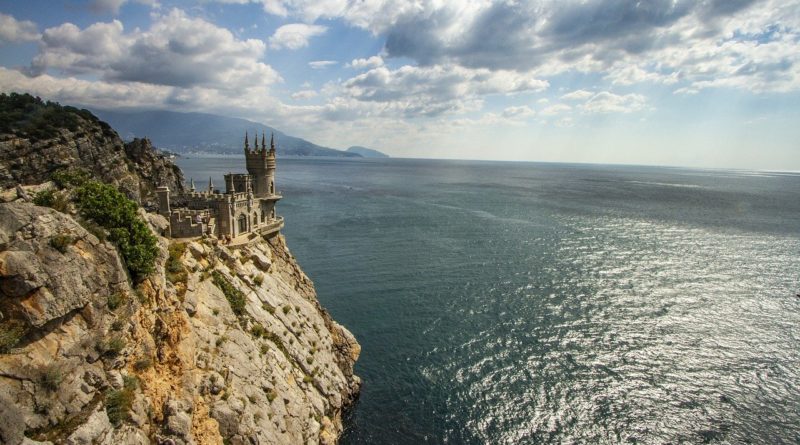Yalta – From Ancient Greece To Modern Time
Yalta is a town on the south coast of the Crimean Peninsula surrounded by the Black Sea. It came to worldwide attention in 1945 when the Yalta Conference between the “Big Three” powers – the Soviet Union, the United States and the United Kingdom – was held at the “Livadia Palace”, but long time before and after that historical meeting, Yalta was a resort city. It serves as the administrative center of Yalta Municipality, one of the regions within Crimea. It has a warm humid subtropical climate and is surrounded by numerous vineyards and orchards.
Ancient Greek Times
There is a theory saying that the town is actually located on the site of the ancient Greek colony. It is situated in a deep bay that faces south towards the Black Sea and surrounded by the mountain range Ai-Petri, which is, conveniently, a Greek originated name meaning Saint Peter. It is even easier to imagine Greek settlers founding a colony there when you know that Greek word for a safe shore on which to land is “yalos”.
Between Two Empires
Yalta was first recorded and described in the 12th century by an Arab geographer, as a Byzantine port and fishing settlement. The city became part of a network of Genoese trading colonies on the Crimean coast in the 14th century. In those times it was known as Etalita or Galita. Crimea was captured by the Ottoman Empire in 1475, which made it a semi-independent subject territory under the rule of the Crimean Khanate but the southern coast with Yalta was under direct Ottoman rule forming the Eyalet of Kefe (Feodosiya).
Following the Treaty of Kuchuk-Kainarji that ended the Russo-Turkish War of 1768–74 and marked a defeat of the Ottomans in their struggle against Russia,
Yalta was formally annexed by the Russian Empire in 1783, ruled by Catherine the Great, along with the rest of Crimea, sparking the Russo-Turkish War, 1787-1792. Prior to the annexation of the Crimea, the Crimean Greeks were moved to Mariupol in 1778; one of the villages they established nearby is also called Yalta.
At the second half of the 19th century, the town became a fashionable resort for the Russian aristocracy and gentry. Probably the most famous people of that time seeking relaxation, or just a warmer climate, waere Leo Tolstoy who spent summers there and Anton Chekhov who in 1898 bought a house (the White Dacha) here, where he lived till 1902. Yalta is the setting for Chekhov’s short story, “The Lady with the Dog”. His “Three sisters” were, also, written in Yalta . At the turn of the century, the town was closely associated with royalty. In 1889 Tsar Alexander III finished the construction of “Massandra Palace” in just a short distance to the north of Yalta and Nicholas II built the “Livadia Palace” south-west of the town.
Decay
During most of the 20th century, Yalta was the principal holiday resort of the Soviet Union. In 1920 started the transformation of the city and the entire region from a fairly exclusive resort area into a recreation facility for tired proletarians, all of that by the decree “On the Use of Crimea for the Medical Treatment of the Working People”, which was issued by Vladimir Lenin. Numerous workers’ sanatoria were constructed in Yalta and around the surrounding district. There were just a few other places that Soviet citizens could come for a seaside holiday, because foreign travel was forbidden to all, except for a handful of people. The Soviet elite also came to Yalta; the Soviet premier Joseph Stalin used none the less, but the Massandra Palace as his summer residence. During the second world war Yalta was occupied by the German Army from 9 November 1941 to 16 April 1944.
After the breakdown of the Soviet Union in 1991, Yalta has struggled economically. Many of the newly-enriched people of the ex-Soviet Union began going to other European holiday resorts, now that they had the freedom and money to travel. At the same time, the impoverishment of many ex-Soviet citizens meant that they could no longer afford to go to Yalta. The town’s transport links have been reduced so much that almost all passenger traffic by sea ended completely. One of the traffic curiosities is that the longest trolleybus line in Europe still goes from the train station in Simferopol to Yalta (almost 90 km).
Modern Time
In modern times Yalta is crowded in the vacation season (July–August) and prices for accommodation are very high. Most of the tourists are from countries of the former Soviet Union; but from 2013 in which the number of Western tourists was about 12%, the number of Western tourists is rising. Most of them come by more than 200 cruise ships that sail into Yalta every year.
Yalta has a beautiful seafront promenade along the Black Sea. It is a wonderful place for strolling during all seasons of the year, and it also serves as a place to gather and talk, to see and be seen. There are several beaches to the east and west of the promenade. The town has quite a few movie theaters, a drama theater, plenty of restaurants, and several open-air markets.
Two beaches in Yalta are Blue Flag beaches since May 2010, these were the first beaches (with two beaches in Yevpatoria) to be awarded a Blue Flag in a CIS member state.

